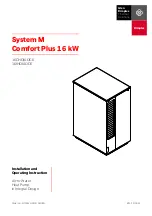
Operation manual
7
E(D/B)(H/L)Q011~0W1
Unit for air to water heat pump system and options
4PW51122-1
What can the schedule timer NOT do?
The schedule timer can not change the operation mode from space
cooling to space heating or vice versa.
How to interpret the programmed actions
To be able to understand the behaviour of your installation when the
schedule timer is enabled, it is important to keep in mind that the
"last" programmed command overruled the "preceding" programmed
command and will remain active until the "next" programmed
command occurs.
Example: imagine the actual time is 17:30 and actions are
programmed at 13:00, 16:00 and 19:00. The "last" programmed
command (16:00) overruled the "previous" programmed command
(13:00) and will remain active until the "next" programmed command
(19:00) occurs.
So in order to know the actual setting, one should consult the last
programmed command. It is clear that the "last" programmed
command may date from the day before. Refer to
"Consulting
programmed actions" on page 9
.
Programming and consulting the schedule timer
Getting started
Programming the schedule timer is flexible (you can add, remove or
alter programmed actions whenever required) and straightforward
(programming steps are limited to a minimum). However, before
programming the schedule timer, remind:
■
Familiarise yourself with the icons and the buttons. You will need
them when programming. Refer to
"Name and function of
buttons and icons" on page 3
.
■
Fill out the form at the very end of this manual. This form can
help you define the required actions for each day. Keep in mind
that:
-
In the space cooling/heating program, 5 actions can be
programmed per weekday. The same actions are repeated
on a weekly basis.
-
In the domestic water heating, booster heater and quiet
mode program, 5 actions can be programmed per mode. The
same actions are repeated on a daily basis.
■
Take your time to enter all data accurately.
■
Try to program the actions in a chronological way: start with
action 1 for the first action and end with the highest number for
the last action. This is not a requirement but will simplify the
interpretation of the program later.
■
If 2 or more actions are programmed for the same day and at the
same time, only the action with the highest action number will be
executed.
■
You can always alter, add or remove the programmed actions
later.
■
When programming heating actions (time and set point), cooling
actions are added automatically at the same time but with the
predefined default cooling set point. Conversely, when
programming cooling actions (time and setpoint), heating
actions are added automatically at the same time but with the
default heating set point.
The set points of these automatically added actions can be
adjusted by programming the corresponding mode. This means
that after programming heating, you should also program the
corresponding cooling set points and vice versa.
NOTE
During schedule timer operation, someone may have
altered the actual settings manually (in other words,
the "last" command was overruled manually). The icon
p
, indicating the schedule timer operation, may still be
displayed, giving the impression that the "last"
command settings are still active. The "next"
programmed command will overrule the altered
settings and return to the original program.
Due to the fact that the schedule timer cannot switch
between operation modes (cooling or heating) and the fact
that each programmed action implies a cooling setpoint
and a heating setpoint, the following situations may occur:
■
when the schedule timer is active in heating mode,
and the mode is changed manually to cooling (by
means of the
=
button), the operation mode will
from then on remain cooling and program actions will
follow the corresponding cooling setpoints. Returning
to heating mode needs to be carried out manually (by
means of the
=
button).
■
when the schedule timer is active in cooling mode,
and the mode is changed manually to heating (by
means of the
=
button), the operation mode will
from then on remain heating and program actions will
follow the corresponding heating setpoints. Returning
to cooling mode needs to be carried out manually (by
means of the
=
button).
The above proves the importance of programming both
cooling and heating setpoints for each action. If you do not
program these setpoints, the predefined default values will
be used.








































